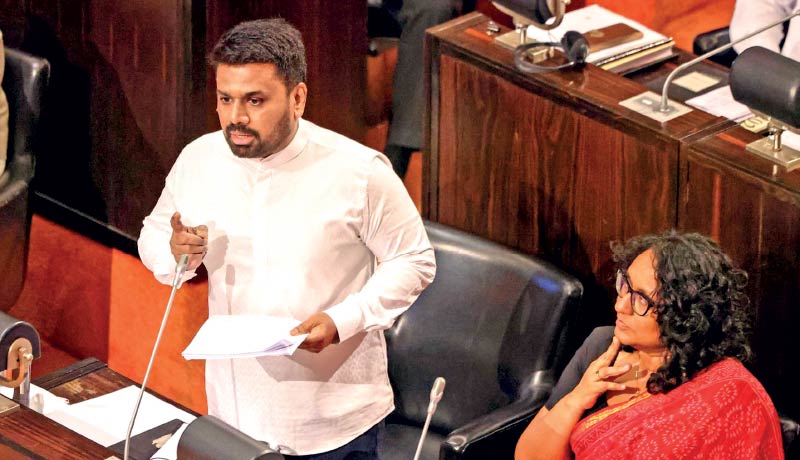Thursday Nov 27, 2025
Thursday Nov 27, 2025
Thursday, 27 November 2025 00:22 - - {{hitsCtrl.values.hits}}

 The 2026 Budget represents not just a financial roadmap, but a moral and strategic moment; one where public ambition for sustainable growth, environmental stewardship, and inclusive development must translate into real, bankable projects. While the Budget speech by President/Finance Minister Honourable Anura Kumara Dissanayake signals many promising directions (Full Budget Speech 2026), the challenge now is effective delivery. For investor firms this brings both an opportunity and a responsibility: to align vision with national priorities, and to mobilise capital, expertise and partnerships to turn policy into impact.
The 2026 Budget represents not just a financial roadmap, but a moral and strategic moment; one where public ambition for sustainable growth, environmental stewardship, and inclusive development must translate into real, bankable projects. While the Budget speech by President/Finance Minister Honourable Anura Kumara Dissanayake signals many promising directions (Full Budget Speech 2026), the challenge now is effective delivery. For investor firms this brings both an opportunity and a responsibility: to align vision with national priorities, and to mobilise capital, expertise and partnerships to turn policy into impact.
1. The big picture: What the 2026 Budget promises
The 2026 Budget is framed around three interlocking themes: economic recovery, investment confidence, and green transformation. In his speech, President Dissanayake emphasised replacing “cronyism with partnership,” and embedding predictability and rule-based incentives to attract quality investment. Key structural reform measures include:
1. Amendments to the Strategic Development Projects Act and the Colombo Port City Commission Act, aimed at streamlining foreign direct investment (FDI) processes and making incentive systems more transparent.
2. A PPP (Public-Private Partnership) Act, with a draft bill submitted for public consultation and parliamentary approval.
3. A new Investment Protection Act, scheduled for passage in early 2026, to protect foreign and domestic investors.
4. Significant allocations to SMEs, rural credit, and agricultural value chains: loans of up to LKR 50 million for SMEs, concessional loans for agriculture via a New Comprehensive Rural Credit Scheme (NCRCS), and a dedicated “Sustainable Farmers’ Loan Fund” (LKR 800 million) to support climate-smart farming.
5. A bold irrigation investment package, with Rs. 91,700 million allocated to lift up irrigation infrastructure and water systems.
6. A push for green energy, tied to new economic opportunities — including data centres, green hydrogen, and transport electrification.
These commitments align strongly with Sri Lanka’s broader climate goals: under its NDC 3.0 (2026–2035), the government places a major emphasis on mitigation and adaptation in sectors like energy and agriculture, with 75% of its emissions reduction target coming from the power sector and 7.5% from agriculture (UNFCCC).
2. What’s right: The strengths and strategic opportunities
A. Focus on core sectors: Agriculture and Irrigation
The emphasis on irrigation with nearly Rs. 91,700 million is a strong signal that the government regards water infrastructure not just as a social good, but as a core economic lever (Full Budget Speech 2026, Irrigation section). These investments are critical for stabilising farm productivity, enabling climate-resilient agriculture, and increasing rural incomes. By linking these irrigation investments with agricultural credit and value-chain financing, the Budget recognises that infrastructure alone is not enough: farmers need real support to translate water into value.
President Dissanayake has also highlighted the importance of transforming the livestock sector — especially dairy — into a commercial industry rather than subsistence farming. This shift could reduce Sri Lanka’s import dependence, support rural livelihoods, and build a value-add agricultural
sector.
B. Green energy with an economic twist
Rather than viewing green energy purely in environmental terms, the Budget ties renewables to industrial growth, export potential, and data-driven demand. This is smart because it aligns climate goals with economic (and revenue) goals.
The reform measures — PPP Act, Investment Protection Act — also send a signal of seriousness: investors need legal certainty, protection, and predictable deal structures.
Beyond policy, international development partners are already stepping in. For example, the World Bank Group has committed $150 million to support Sri Lanka’s energy transition, specifically to help scale solar and wind, modernise the grid, and de-risk payments to the Ceylon Electricity Board (CEB) by offering guarantees (World Bank).
C. Building competitiveness: SME and farmer financing
By allocating funds to SMEs and smallholder farmers, the government is showing that growth should not just be driven by mega-projects — but by the small businesses and farmers who power Sri Lanka’s rural economy.
The Sustainable Farmers’ Loan Fund (Rs. 800 million) is particularly noteworthy: its purpose is to help farmers adopt climate-resilient practices, invest in processing or storage, and scale sustainable farming systems.
Furthermore, the World Bank’s Rurban project (Rural-Urban Development and Climate Resilience) is aligned with this strategy. The Bank is providing $ 100 million to support smallholder farmers, improve irrigation on 71,000 hectares, promote modern climate-smart agriculture, and strengthen agri-food value chains.
D. Regulatory reforms to unlock investment
The steps to improve the investment climate are real and potentially transformative: legal instruments, PPP frameworks, and value-chain-focused zones for SMEs.
By building “auxiliary zones” linked to main investment zones, the government is creating space for SMEs to integrate into industrial value chains and benefit from spillover effects.
3. The risks and gaps: What the Budget overlooks or undermines
Despite many forward-looking commitments, the 2026 Budget is not without serious challenges. These gaps, if unaddressed, could undermine its transformative potential.
A. Energy sector reform risk
While the Budget promises a green energy push, the real resources for key enablers — such as energy storage or grid modernisation — remain limited. The World-Bank program helps, but the scale of ambition (e.g., green hydrogen, transport electrification) requires more than incremental investment.
There is also a lingering risk around the Ceylon Electricity Board: unless it is reformed meaningfully, inefficiencies, losses, and financial stress could continue to be a bottleneck for new private investment.
B. Implementation risk and institutional capacity
Allocations in the Budget are promising, but delivery will be difficult. The PPP Act, Investment Protection Act, and FDI reforms all require strong institutions, transparent procurement, and long-term political commitment to be effective. Without building the relevant institutional capacity, many of these reforms might remain on paper.
Sri Lanka’s track record with large PPP projects is mixed. Poor contract design, opaque bidding, and misaligned incentives could lead to cost overruns or under-delivering.
C. Financing gap and long-term capital
Public funds will not be sufficient. To deliver on green energy, irrigation modernisation, and climate-smart agriculture, Sri Lanka needs billions of dollars in private and blended finance. The Budget’s signals are good, but they must be translated into bankable projects, de-risked structures, and a credible project pipeline to attract DFIs, impact investors, and corporates.
At the same time, lending to smallholder farmers carries real risks: default, climate shocks, price volatility. Without aggregation, insurance, and off-take mechanisms, credit may not translate into real, scalable transformation.
D. Accountability and monitoring shortcomings
The Budget speech is rich in aspiration, but weak on concrete monitoring mechanisms: What are the key performance indicators (KPIs)? How will irrigation funds be disbursed and tracked? Over what timeframe will PPPs and green projects be evaluated? Without a publicly accessible dashboard, progress will be difficult to measure, and trust will suffer.
There is also a risk of fiscal slippage: macroeconomic assumptions may not hold, especially given external risks (currency, debt, interest rates). Without strict fiscal discipline, the ambitions in the Budget could be undermined.
4. What needs to happen: From promise to reality
To maximise the potential of the 2026 Budget, several concrete actions are required. This is where NWG can play a catalytic role.
A. Develop bankable project pipelines
NWG should lead in structuring project-ready pipelines in high-impact areas:
1. Agrivoltaic + Drying Hubs: Combine solar power, crop-drying and processing, and farm clustering — financed via PPPs or blended finance.
2. Irrigation Electrification: Modernise irrigation systems using solar-powered pumps, smart water management, and drip infrastructure.
3. Green Hydrogen Pilot: Leverage off-peak renewables to produce green hydrogen (or green ammonia), exploring off-take via fertilisers, industrial use, or export.
These projects should come with full feasibility studies, financial models, ESG frameworks, community plans, and risk management structures.
B. Forge blended finance partnerships
Investment Firms should proactively engage with multilateral development banks, DFIs, impact funds, and private equity to mobilise blended capital:
C. Policy advocacy and technical support
Provide technical support to improve regulatory frameworks (e.g., grid access, tariffs, permitting) to accelerate project deployment.
D. Strengthen farmer aggregation and off-take mechanisms
To reduce credit risk and build scale:
E. Promote transparency and accountability
To build trust and ensure impact, NWG should advocate for:
5. How others can join hands with investment firms
To unlock the full potential of the 2026 Budget, collaboration is vital. Here’s how different actors can partner:
6. Risks we must watch — and how to mitigate them
For the investment firms and its partners, the major risks include:
1. Political/Policy risk: Promised reforms may be delayed or diluted.
2. Execution risk: Infrastructure projects may overrun.
3. Market risk: Off-take (e.g., for hydrogen or processed crops) may not materialise.
4. Credit risk: Farmers default due to climate or market shocks.
5. Financial risk: Macroeconomic instability (currency, debt) could undermine viability.
7. The urgency for action — and the window to seize
There has perhaps never been a more critical moment for Sri Lanka. The 2026 Budget sends a powerful signal — that the government is serious about structural transformation. But signals are only as good as what follows. The window to convert budget ambition into real, on-the-ground green energy plants, flourishing farms, and modern infrastructure is open, but it will not stay open for long.
8. Call to action: What we urge the Government and stakeholders to do
To translate the promise of the 2026 Budget into real transformation, we urge:
1. Form a Green Infrastructure Task Force — bring together Ministries (Power, Agriculture, Finance), DFIs, NWG, private sector to design and prioritise a “green-agripipeline.”
2. Fast-track PPP and Investment Legislation — ensure the PPP Act and Investment Protection Act are passed, with clear procurement rules and investor protection.
3. Establish a Public-Private Delivery Unit in government to coordinate flagship projects (e.g., agrivoltaics, irrigation).
4. Launch a Transparent Monitoring Dashboard — publicly track commitments, disbursements, and impact.
5. Set up a Blended Finance Platform — NWG partners with DFIs and private capital to pool blended funds for green-agri projects.
6. Hold Regular Stakeholder Dialogues — bring together farmers, communities, private sector, civil society to monitor progress and adapt as needed.
10. Conclusion
The 2026 Budget offers a rare and promising blueprint. It signals alignment — between ambition and pragmatism, between green goals and economic growth, between state-led priorities and private capital. But ambition without delivery is simply aspiration. The burden now falls on all of us — government, private sector, financiers, civil society — to step up, execute, and hold each other accountable. Let us not let this moment slip. Let us build.
(The author is the Founder and CEO of Noteworthy Global, a UK-based investment firm connecting high-potential projects with forward-thinking investors. He is a clean tech and ESG advocate with over 20 years in IT project management, and bridges global investment, technology, and sustainability to deliver measurable social, environmental, and financial impact. He could be reached via email at [email protected]
References
Full Budget Speech 2026. Media Ministry, Sri Lanka.
“Sri Lanka Budget 2026 Summary”. Daily Mirror.
“Sri Lanka to grow 3.5% in 2025 despite tariff headwinds, says World Bank.” Reuters.
“Sri Lanka Group and Sri Lanka Partner to Boost Agricultural Productivity …” World Bank press release.
“World Bank Group to Support Sri Lanka’s Clean Energy Transition with $150 Million Program.” World Bank.
“Sri Lanka’s Nationally Determined Contributions (NDC) 3.0 (2026–2035)”. UNFCCC.
“Sri Lanka borrows USD 100 M for agri project.” Zira Daily.
“How Sri Lanka’s Sudden Organic Farming Policy Led to National Food Crisis.” Reddit discussion (context on sustainable farming risk).